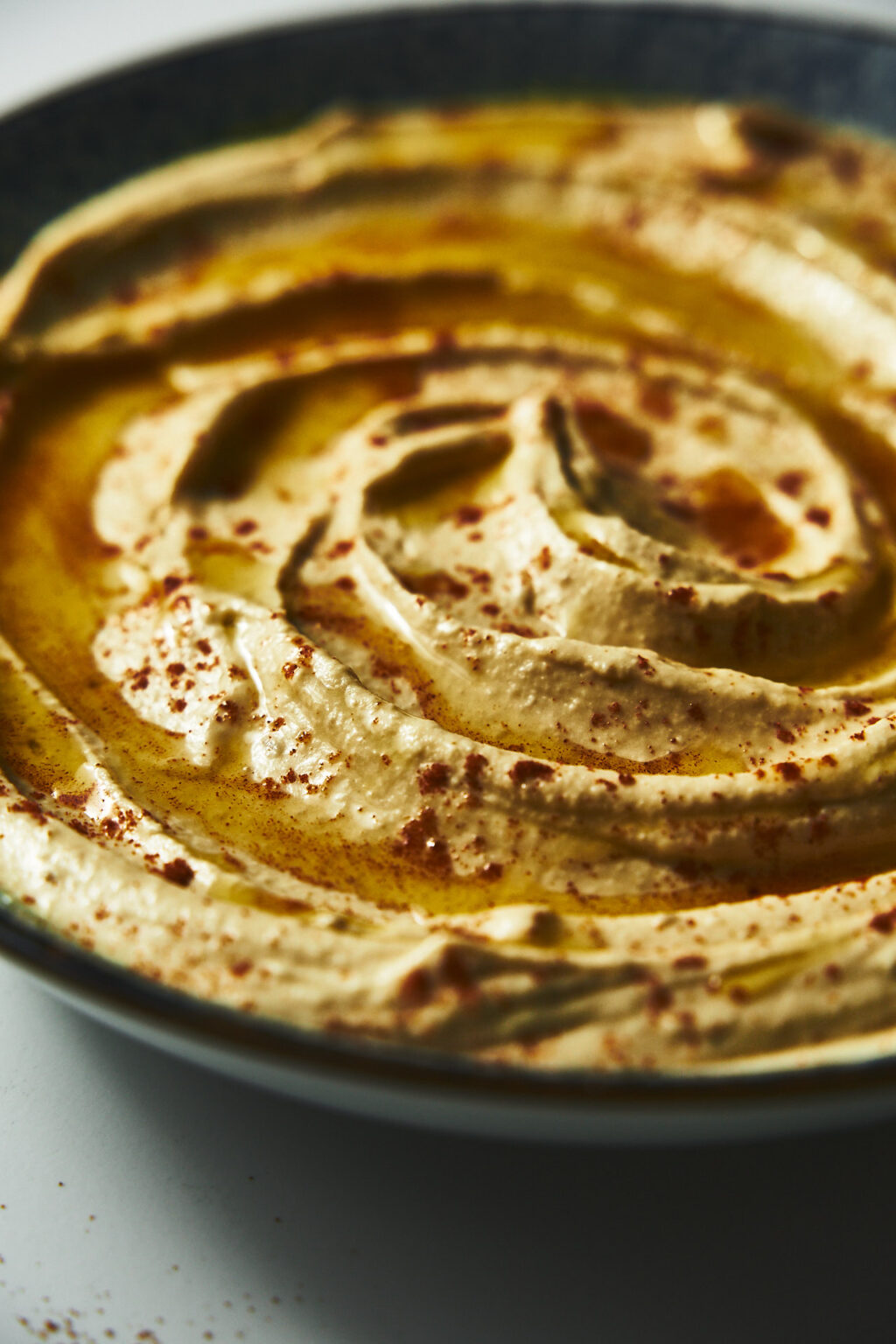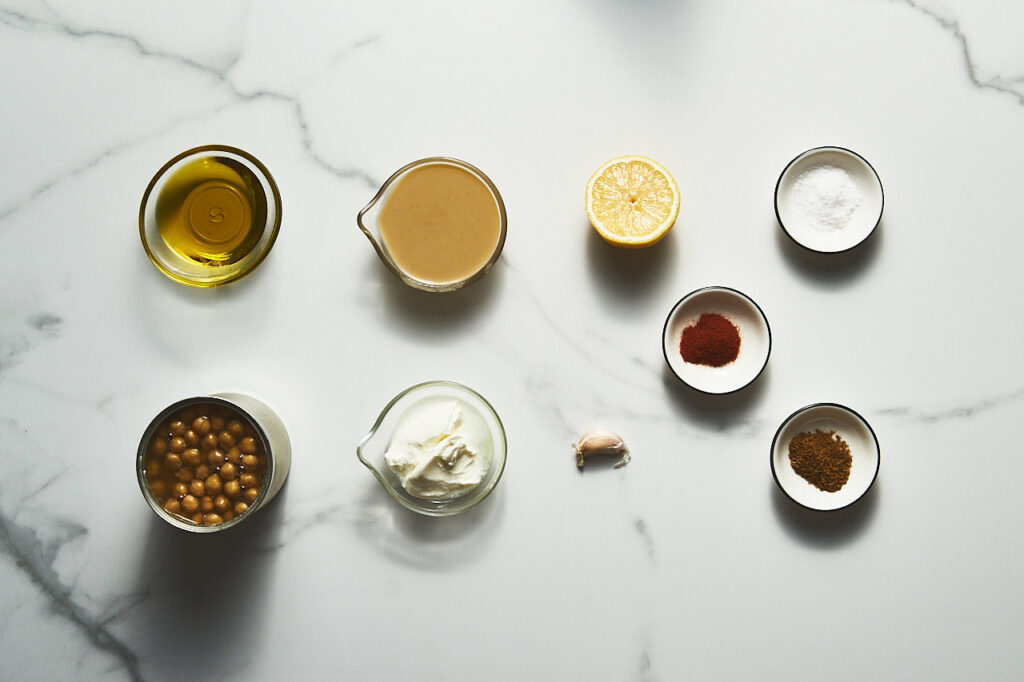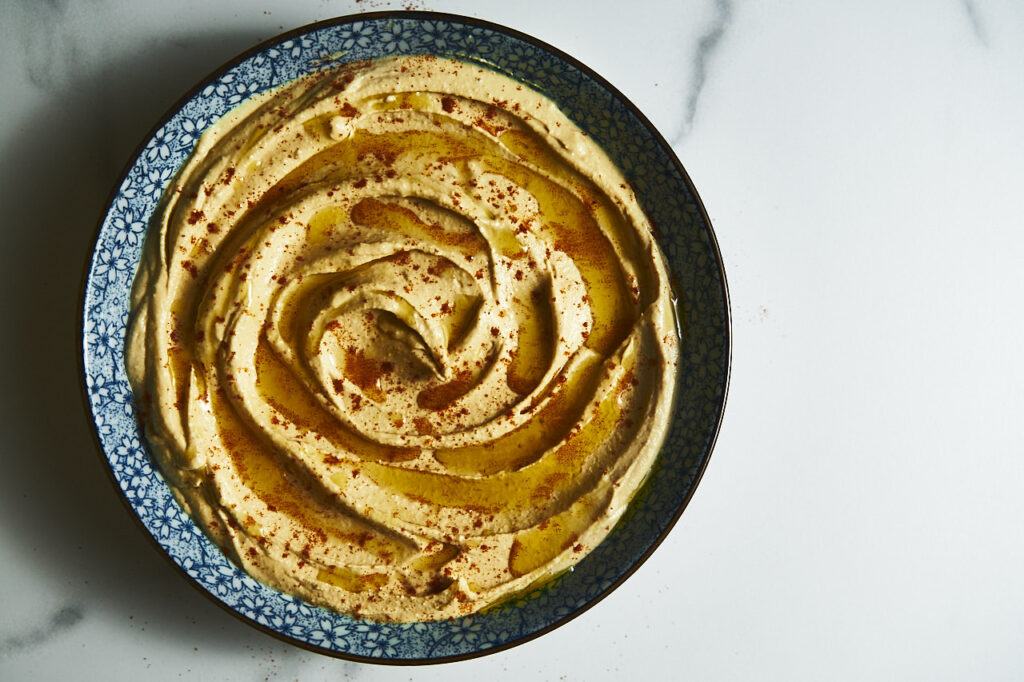Traditional hummus is made primarily from chickpeas, tahini, olive oil and lemon juice. The Turkish version of hummus, on the other hand, often incorporates a wider range of ingredients and flavors.
Unlike other variants, which are often served cold, Turkish hummus can be served warm, often topped with toppings such as pastrami (basturma, beef jerky) or sautéed lamb, turning it from a simple appetizer into a hearty meal.
The addition of yogurt, as in our version, is not universal, but is a delightful twist, giving the dish, a tartness and creamy texture that contrasts beautifully with the nuttiness of the tahini and the earthiness of the chickpeas.
While traditional hummus is creamy and rich, the addition of Turkish (or Greek) yogurt gives it a light and refreshing aftertaste.
Serve this hummus with warm flatbreads (yeast-free pita, bazlama, Ramadan pita, simit) or sliced fresh vegetables.
It can be included in meze, accompanied by olives, stuffed grape leaves and baba ghanoush.
Contents

⏱ Cooking time — 15 minutes overall. Includes 15 minutes of preparation and cooking + 0 minutes unattended.
🔪 Ingredients
For 4 servings:
- 400 g (14 oz) chickpeas (1 can canned or ~120 g dry chickpeas soaked overnight in water and boiled until soft)
- 1 clove of garlic
- 60 g (2 ⅛ oz) tahini
- 60 g (2 ⅛ oz) Turkish yogurt (or Greek yogurt)
- 30 ml (2 tbsp.) olive oil
- ½ tsp ground cumin
- 1 tsp. salt
- ½ lemon (juice)
- ½ tsp. paprika for decoration

🥣 Instructions
👉 Jump to Short Version of RecipePreparation of chickpeas
Open 1 can of chickpeas (400 g or about 14 ounces) and drain the liquid.
To make the hummus smoother and more tender – the chickpeas need to be peeled from the outer husks. This step is optional, but recommended. It is very easy to do.
Place the chickpeas in a large bowl and fill with water so that it completely covers the chickpeas. Take a handful of chickpeas and gently rub them between your palms to remove the skins. To remove the skins more easily, let the chickpeas soak in water for 3-4 minutes. The outer husk will float on the surface, gently drain the water with it.
Refill the bowl with water and repeat the skinning process 1-2 more times until all (or almost all) of the chickpeas have been peeled.
Mixing ingredients
Place the cleaned chickpeas in a blender bowl.
Add the juice of half a lemon and the following ingredients: 1 garlic clove, 60 g (2 ⅛ oz) Turkish yogurt (4 tbsp.) and 60 g (2 ⅛ oz) tahini (4 tbsp.), ½ tsp. ground cumin and 1 tsp. salt.
Blending
Turn on the blender. Blend until a creamy mixture is formed. This should take about 1 minute.
Turn off the blender, open the lid and scrape the mixture off the sides of the bowl with a spatula.
Start the blender again. Slowly pour in 30 ml of olive oil (2 tbsp.) in a thin stream.
Check to see if the hummus is ready. If you are using a hand blender or food processor, it may take longer.
Taste the hummus for flavor. Add more salt, lemon juice and yogurt if desired.
Blend everything in the blender again.
Serving and serving
Place the hummus on a plate.
Serve immediately or cover the plate with clingfilm and put it in the refrigerator for 1-2 hours.
Sprinkle the hummus with ½ tsp. of paprika before serving. If desired, you can also garnish the hummus with pomegranate seeds.
Drizzle the hummus with olive oil before serving.

🙋♂️ FAQ
How is Turkish Hummus different from traditional Middle Eastern hummus?
Turkish Hummus incorporates yogurt, which adds a creamy texture and tangy flavor, distinguishing it from the traditional Middle Eastern hummus which mainly relies on tahini and chickpeas.
Can I use Greek yogurt for this recipe?
Yes, Greek yogurt can be used and will give the hummus an even creamier texture. However, if it’s too thick, you can thin it with a little water or olive oil.
I don’t have tahini. Can I skip it?
While tahini adds a unique flavor and richness to hummus, if you don’t have it, the yogurt will still give the hummus a creamy consistency. The flavor will be different, but still delicious.
Can I add herbs or spices to Turkish Hummus?
Absolutely! Popular additions include paprika, cumin, fresh dill, or parsley.
How long can I store Turkish Hummus in the refrigerator?
Turkish Hummus can be stored in an airtight container in the refrigerator for up to 4-5 days. Give it a good stir before serving.
Can I freeze Turkish Hummus?
While you can freeze it, the texture might change slightly once thawed, becoming a bit grainier. It’s best consumed fresh, but if you have to freeze it, store in an airtight container and consume within a month.
What can I serve with Turkish Hummus?
Turkish Hummus can be served with a variety of accompaniments like fresh pita bread, cucumber slices, carrot sticks, olives, or even as a spread in sandwiches and wraps.
Can I prepare this hummus a day ahead of serving?
Yes, making it a day ahead can actually allow the flavors to meld better. Store it in an airtight container in the refrigerator and give it a good stir before serving.
Can I use other beans or legumes instead of chickpeas?
While chickpeas are traditional, you can experiment with other beans like white beans or black beans. However, the flavor and texture will differ.
Can I make this hummus spicier?
Certainly! You can add red pepper flakes, cayenne pepper, or even a dash of hot sauce to spice it up according to your preference.
Is there a vegan version of Turkish Hummus?
Traditional Turkish Hummus with yogurt is not vegan. However, you can substitute the yogurt with a plant-based alternative or omit it altogether, though the flavor profile will change.
Can I add roasted vegetables to this hummus?
Roasted vegetables like bell peppers, garlic, or eggplant can be added to the hummus for added flavor. They should be blended in with the other ingredients.
Does Turkish Hummus with Yogurt require more salt due to the addition of yogurt?
It’s always best to salt to taste. Start with a small amount and adjust based on your preference, especially since yogurt can sometimes add its own tanginess that might balance out flavors differently than regular hummus.
📌 Pin it!




Turkish Hummus with yogurt

Ingredients
- 400 g chickpeas (1 can canned or ~120 g dry chickpeas soaked overnight in water and boiled until soft)
- 1 clove of garlic
- 60 g tahini
- 60 g Turkish yogurt (or Greek yogurt)
- 30 ml olive oil
- ½ tsp. ground cumin
- 1 tsp. salt
- ½ lemon (juice)
- ½ tsp. paprika for decoration
Instructions
- Drain the liquid from the can of chickpeas. Clean the chickpeas from the outer husks by soaking them in water and then kneading them between the palms of your hands. Drain the water and husks, making sure the chickpeas are all cleaned.
- Place the chickpeas in the bowl of a blender. Add the juice of half a lemon, garlic, chickpea yogurt, tahini, cumin and salt.
- Blend for about 1 minute until creamy. Add olive oil and continue to whisk again. Adjust the flavor, adding more salt, lemon juice or yogurt if desired.
- Place hummus on a plate and chill in the refrigerator for 1-2 hours. Before serving, sprinkle with paprika and garnish as desired. Drizzle with olive oil.
